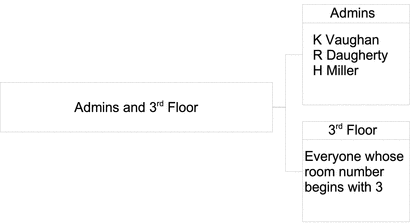Static, Dynamic, and Nested Groups
Directory Server distinguishes between two main kinds of groups; static groups and dynamic groups. Nested groups and mixed groups
Although groups may identify members anywhere in the directory, the group definitions themselves should be located under an appropriately named node such as ou=Groups. This makes them easy to find, for example, when defining access control instructions (ACIs) that grant or restrict access when the bind credentials are members of a group.
Static Groups
Static groups explicitly name their member entries. For example, a group of directory administrators would name the specific people who formed part of that group, as shown in the following illustration.

The following LDIF extract shows how the members of this static group would be defined.
dn: cn=Directory Administrators, ou=Groups, dc=example,dc=com ... member: uid=kvaughan, ou=People, dc=example,dc=com member: uid=rdaugherty, ou=People, dc=example,dc=com member: uid=hmiller, ou=People, dc=example,dc=com
Dynamic Groups
Dynamic groups specify a filter and all entries that match the filter are members of the group. These groups are dynamic because membership is defined each time the filter is evaluated.
Imagine, for example, that all management employees and their assistants were situated on the 3rd floor of your building, and that the room number of each employee commenced with the number of the floor. If you wanted to create a group containing just the employees on the third floor, you could use the room number to define just these employees, as shown in the following illustration.

The following LDIF extract shows how the members of this dynamic group would be defined.
dn: cn=3rd Floor, ou=Groups, dc=example,dc=com ... memberURL: ldap:///dc=example,dc=com??sub?(roomnumber=3*)
Nested Groups
Nested groups use the DN of another group as the uniqueMember attribute of a static or dynamic group to place groups inside other groups. Directory Server also supports mixed groups, that is groups that reference individual entries, static groups, and dynamic groups.
Imagine for example that you wanted a group containing all directory administrators, and all management employees and their assistants. You could use a combination of the two groups defined earlier to create one nested group, as shown in the following illustration.

The following LDIF extract shows how the members of this nested group would be defined.
dn: cn=Admins and 3rd Floor, ou=Groups, dc=example,dc=com ... member: cn=Directory Administrators, ou=Groups, dc=example,dc=com member: cn=3rd Floor, ou=Groups, dc=example,dc=com
Nested groups are not the most efficient grouping mechanism. Dynamic nested groups incur an even greater performance cost. To avoid these performance problems, consider using roles instead.
- © 2010, Oracle Corporation and/or its affiliates
